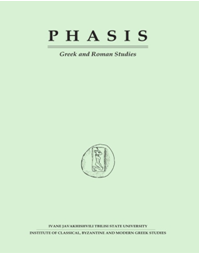Ancient Metal Production Sites from Southwest Georgia in Light of New Archaeological Evidence
DOI:
https://doi.org/10.60131/phasis.17.2014.2327Abstract
The work describes archaeological finds unearthed and studied during a 4 year joint Georgian and British expedition (2010-2012) on the territory of southwestern Georgia. The study of early ironware is admitted to be among the most challenging areas of historical sciences. Broad scholarly interest in it is associated with the significant role of iron in early communities. The early use of iron has been confirmed in many advanced states of the Ancient East, but iron mining and processing (early groups of iron smelting workshops) has not so far been attested in these areas – at least to the extent to meet the local demand. The situation is different on the territory of western Georgia (historical Colchis), where Georgian specialists have discovered and studied a significant number of large-scale mining and metallurgical centers in the last 60 years. Recent findings add more evidence to the opinion that the eastern and south-eastern Black Sea area (historical Colchis) was the important region that produced ancient ironware. However, part of researchers question the early date of iron smelting workshops found in western Georgia (radiocarbon and archaeomagnetic dating). More specifically, they question the geophysical examination results of the 1970s-90s. The joint Georgian-British expedition aimed to specify the date of early iron production in Colchis, which required the application of up-to-date technological methods. In this, we were closely aided by our foreign partners. Besides, earlier findings were described with the help of modern equipment and were mapped. The works also allowed us to observe the transition from iron production to bronze production to make relevant conclusions in the future.
Downloads
Published
Issue
Section
License
Copyright (c) 2014 PHASIS

This work is licensed under a Creative Commons Attribution-NonCommercial 4.0 International License.


